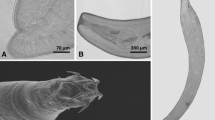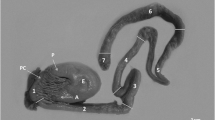Abstract
One and 12 weeks after infection the lesions in the small intestine of two domestic pigs caused byMacracanthorhynchus hirudinaceus were studied by means of light and electron microscopy. Worms of 7 d.p.i. were found to have penetrated with their presoma into the tunica propria and partly into the tunica muscularis where they had caused local mechanic destructions and heavy eosinophilic-like and hemorrhagic reactions. Most eosinophilic-like granulocytes were attracted to the proboscis hooks, at the base of which an osmiophilic substance apparently was excreted. Worms of 84 d.p.i. had penetrated with their proboscis deeply into the tunica muscularis. The presoma had become encapsulated by a solid capsule of necrotic/inflammatory tissue in its inner part and by filamentous connective tissue in its outer part. The predominant leucocytes in the inflammatory tissue now were plasma cells indicating a progressive immune reaction. No worms were found to have perforated the entire intestinal wall as was described from human patients in China.
Zusammenfassung
Die vonMacracanthorhynchus hirudinaceus verursachten Läsionen im Dünndarm von experimentell infizierten Hausschweinen (7 Tage p.i. und 84 Tage p.i.) wurden licht- und elektronenmikroskopisch untersucht. Die Würmer der 84 Tage alten Infektion waren tiefer in die Darmwand eingedrungen als die 7 Tage alten Würmer. Ihr Präsoma wurde von Entzündungsbzw. Bindegewebe umhüllt, das zahlreiche Plasmazellen enthielt. Bei 7 Tage alten Infektionen wurde noch keine Fibrose nachgewiesen. Eosinophilen-ähnliche Granulozyten, die an den Proboscishaken akkumulierten, herrschten in der Läsion vor. Eine osmiophile Gleitflüssigkeit, die offenbar an der Basis der Proboscishaken ausgeschieden wurde, schien eine stark antigene Wirkung auf die Leukozyten des Schweins auszuüben. In keinem Fall wurden Würmer angetroffen, die die gesamte Darmwand perforiert hatten, wie es in China bei Menschen beschrieben wurde.
Similar content being viewed by others
Literatur
Dunagan TT, Miller DM (1980)Macracanthorhynchus hirudinaceus from swine: an eighteen-year record of acanthocephala from Southern Illinois. Proc Helminth Soc Wash 47:33–36
Hemsrichart V, Pichyangkura C, Chitahang S, Vudtichamnong U (1983) Eosinophilic enteritis due toMacracanthorhynchus hirudinaceus infection, report of 3 cases. Med Assoc Thai 66:303–310
Kates KC (1944) Some observation on experimental infection of pigs with the thorny-headed worm,Macracanthorhynchus hirudinaceus. Am J Vet Res 5:166–172
Kliks M, Tantachamrun T, Chaiyaporn V (1974) Human infection by an acanthocephalanMacracanthorhynchus hirudinaceus in thailand, new light on a previous case. Southeast Asian J Trop Med Pub Hlth 5:303–309
Leng YJ, Huang WD, Liang PN (1983) Human infection withMacracanthorhynchus hirudinaceus Travassos 1916 in Guangdong Province, with notes on its prevalence in China. Ann Trop Med Parasitol 77:107–109
Nelson MJ, Nickol BB (1986) Survival ofMacracanthorhynchus ingens in swine and histopathology of infection in swine and racoons. J Parasitol 72:306–314
Rose CJ (1981) Preliminary observations on the performance of villege pigs (Sus scrofa papuensis) under intensive outdoor management. Science in New Guinea 8:156–163
Taraschewski H (1989)Acanthocephalus anguillae in intra- and extraintestinal positions in experimentally infected juveniles of goldfish und carp and in sticklebacks. J Parasitol 75:108–118
Taraschewski H, Sagani C, Mehlhorn H (1989) Host-Parasite interface of acanthocephalans in mammals, 1.Moniliformis moniliformis (Archiacanthocephala) in experimentally infected rats. J Parasitol 75:288–296
Tesana S, Mitrchai J, Chunsuttwat S (1982) Acute abdominal pain due toMacracanthorhynchus hirudinaceus infection: a case report. Southeast Asian J Trop Med Pub Hlth 13:262–264
Wang CX, Li DY, Cai ZX (1981) An investigation onDorysthenes paradoxus infected by the juvenile ofMacracanthorhynchus hirudinaceus in Zhuanghe County, Liaoning Province. Acta Zool Sin 27:371–374 (in chinesisch)
Wang MX (1986) Report on the macracanthorhynchosis. Chinese J Dis in Humans and Animals 2:32–34 (in chinesisch)
Wang PC (1962) Studies on the life history ofMacracanthorhynchus hirudinaceus (Pallas 1781). Acta of Fujian Teachers' College 2:195–214 (in chinesisch)
Author information
Authors and Affiliations
Additional information
Unterstützt durch ein Stipendium der VR China für Herrn Bin Zhao
Rights and permissions
About this article
Cite this article
Zhao, B., Taraschewski, H. & Mehlhorn, H. Licht- und elektronenmikroskopische Untersuchungen zur Histopathogenität vonMacracanthorhynchus hirudinaceus (Archiacanthocephala) in experimentell infizierten Hausschweinen. Parasitol Res 76, 355–359 (1990). https://doi.org/10.1007/BF00928192
Accepted:
Issue Date:
DOI: https://doi.org/10.1007/BF00928192




